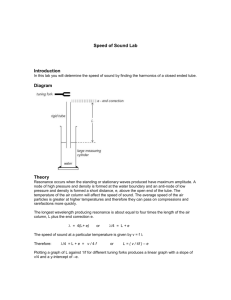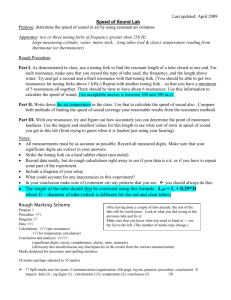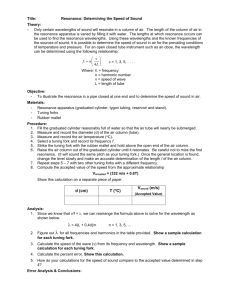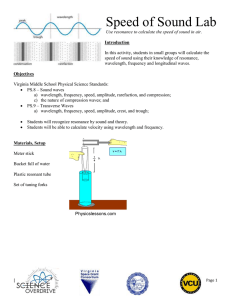Resonant Tubes - Physics at SMU
advertisement
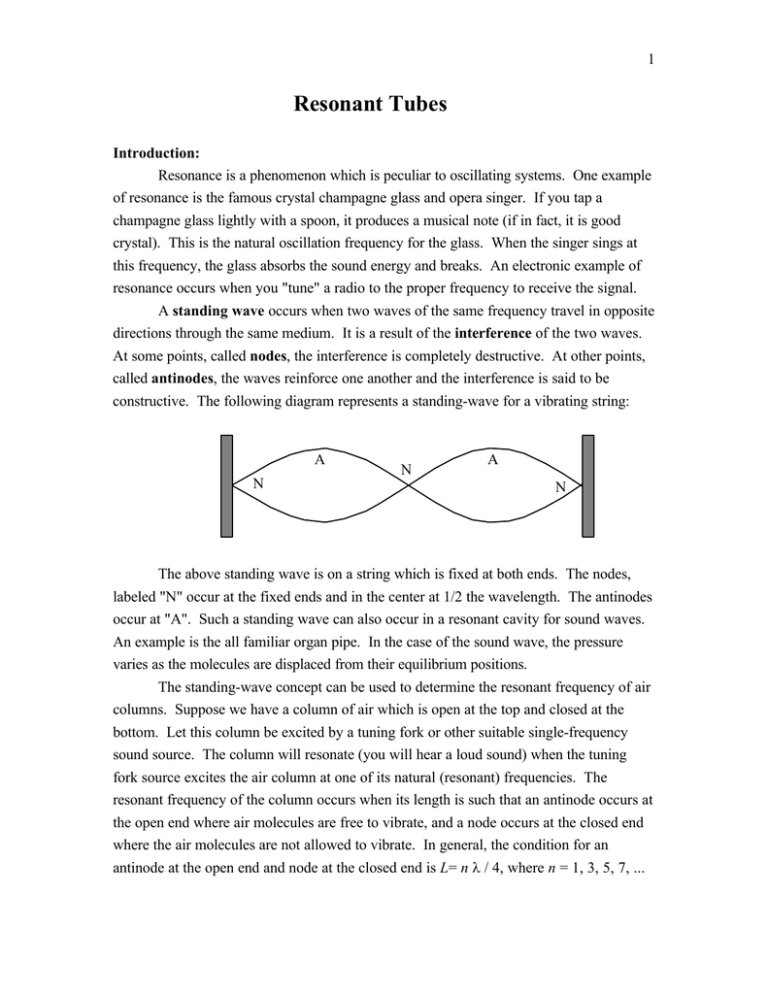
1 Resonant Tubes Introduction: Resonance is a phenomenon which is peculiar to oscillating systems. One example of resonance is the famous crystal champagne glass and opera singer. If you tap a champagne glass lightly with a spoon, it produces a musical note (if in fact, it is good crystal). This is the natural oscillation frequency for the glass. When the singer sings at this frequency, the glass absorbs the sound energy and breaks. An electronic example of resonance occurs when you "tune" a radio to the proper frequency to receive the signal. A standing wave occurs when two waves of the same frequency travel in opposite directions through the same medium. It is a result of the interference of the two waves. At some points, called nodes, the interference is completely destructive. At other points, called antinodes, the waves reinforce one another and the interference is said to be constructive. The following diagram represents a standing-wave for a vibrating string: A N N A N The above standing wave is on a string which is fixed at both ends. The nodes, labeled "N" occur at the fixed ends and in the center at 1/2 the wavelength. The antinodes occur at "A". Such a standing wave can also occur in a resonant cavity for sound waves. An example is the all familiar organ pipe. In the case of the sound wave, the pressure varies as the molecules are displaced from their equilibrium positions. The standing-wave concept can be used to determine the resonant frequency of air columns. Suppose we have a column of air which is open at the top and closed at the bottom. Let this column be excited by a tuning fork or other suitable single-frequency sound source. The column will resonate (you will hear a loud sound) when the tuning fork source excites the air column at one of its natural (resonant) frequencies. The resonant frequency of the column occurs when its length is such that an antinode occurs at the open end where air molecules are free to vibrate, and a node occurs at the closed end where the air molecules are not allowed to vibrate. In general, the condition for an antinode at the open end and node at the closed end is L= n λ / 4, where n = 1, 3, 5, 7, ... 2 In this case, the wavelength is defined by λ = 4 L / n. The length of an air column may be changed by varying the amount of water in a tube. The following diagram illustrates this: open end pressure node pressure antinode water closed end By this method, its length (L) may be "tuned" to resonate with a tuning fork of known frequency. From the above condition for resonance, one can determine the wavelength of the resonances, and if the frequency of the tuning fork is given, one may use the following relationship to calculate the velocity of sound: v=fλ where v = velocity, f = frequency, and λ = wavelength. The objective of this lab is to become familiar with the above principles and use them to find an experimental value for the speed of sound in air. We will then compare this experimental value to an accepted value. The speed of sound in air depends on the temperature. The "accepted speed" for T sound in air is given by the formula: v = vo 273 where vo is the speed of sound at 0° C (331.36 m/sec) and v is the given speed at temperature T (Kelvin). Pressure variations (atmospheric pressure) are small enough to be neglected. 3 Procedure: Note: Use tuning forks with frequency greater than 256 HZ. 1. Fill the reservoir with water where it is in a relatively low position. 2. Hold a vibrating tuning fork over the open end of the tube while changing the water level. Locate a fundamental resonance (loudest sound) by manipulating the water level and reactivating the fork as necessary. 3. Read the water levels X1 and X2 at two successive resonance points (loudest sound) and record them on the data sheet. Calculate the wavelength from the formula: λ = 2 |X1 - X2|. 4. Record the frequency of the tuning fork used. Calculate the velocity of sound and record it. 5. Repeat the above steps for three different frequencies of tuning forks. 6. Record the room temperature with a thermometer. Calculate the accepted speed of sound. Conclusions: 1. Describe your results for this experiment. 2. Name the different factors necessary for a resonance and a standing wave in this apparatus. You may want to draw a picture. 3. If both the ends of the tube were closed (i.e. fixed and rigid), what would the standing waves in the tube look like? You may want to sketch this. 4. Do you think that the diameter of the tube has an effect on the resonance? (Think about the speakers on your stereo.) Explain. Error Analysis: Calculate the % error for your value of the speed of sound. Write down what you think caused a difference from the accepted value. Was your tuning fork really a singlefrequency source? 4 Resonant Tubes Name:_____________________ Abstract: Data: Room temperature:_______ Accepted value for speed of sound in air (v) :_______ test # f X1 X2 λ v % error Calculations: Conclusions: Error Analysis: 1 2 3
